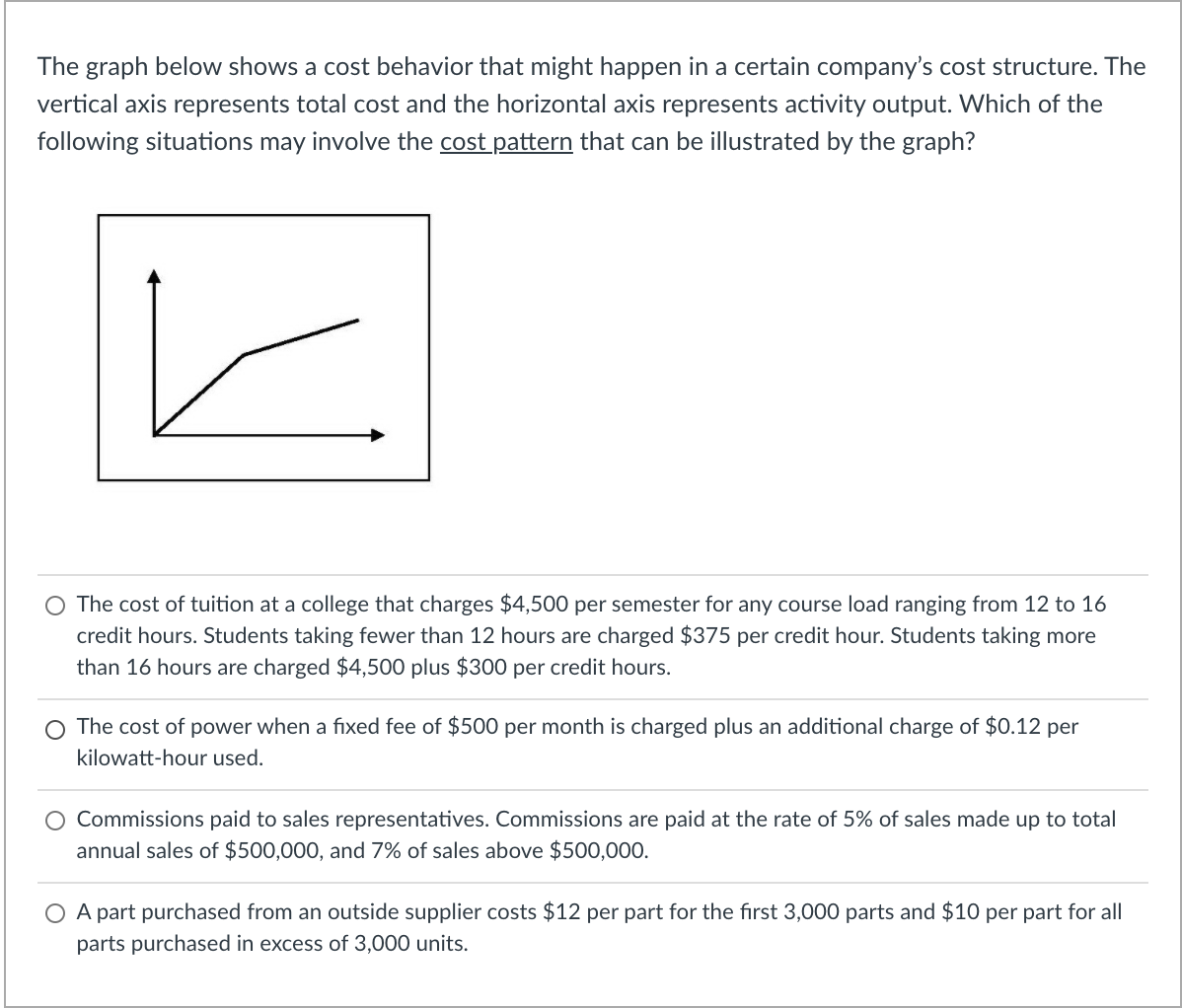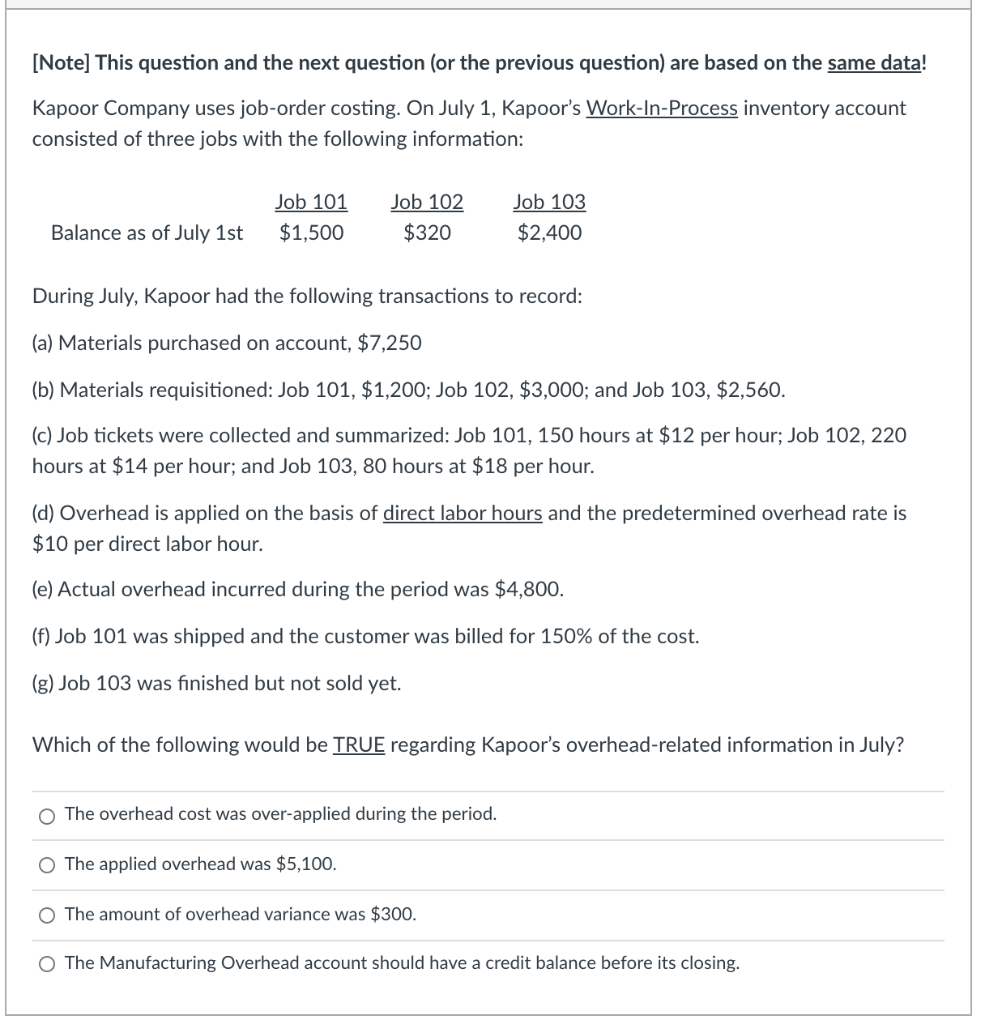


The graph below shows a cost behavior that might happen in a certain company's cost structure. The vertical axis represents total cost and the horizontal axis represents activity output. Which of the following situations may involve the cost pattern that can be illustrated by the graph? r O The cost of tuition at a college that charges $4,500 per semester for any course load ranging from 12 to 16 credit hours. Students taking fewer than 12 hours are charged $375 per credit hour. Students taking more than 16 hours are charged $4,500 plus $300 per credit hours. The cost of power when a fixed fee of $500 per month is charged plus an additional charge of $0.12 per kilowatt-hour used. Commissions paid to sales representatives. Commissions are paid at the rate of 5% of sales made up to total annual sales of $500,000, and 7% of sales above $500,000. O A part purchased from an outside supplier costs $12 per part for the first 3,000 parts and $10 per part for all parts purchased in excess of 3,000 units. [Note] This question and the next question (or the previous question) are based on the same data! Kapoor Company uses job-order costing. On July 1, Kapoor's Work-In-Process inventory account consisted of three jobs with the following information: Job 101 $1,500 Job 102 $320 Job 103 $2,400 Balance as of July 1st During July, Kapoor had the following transactions to record: (a) Materials purchased on account, $7,250 (b) Materials requisitioned: Job 101, $1,200; Job 102, $3,000; and Job 103, $2,560. (c) Job tickets were collected and summarized: Job 101, 150 hours at $12 per hour; Job 102, 220 hours at $14 per hour; and Job 103, 80 hours at $18 per hour. (d) Overhead is applied on the basis of direct labor hours and the predetermined overhead rate is $10 per direct labor hour. (e) Actual overhead incurred during the period was $4,800. (f) Job 101 was shipped and the customer was billed for 150% of the cost. (g) Job 103 was finished but not sold yet. Which of the following would be FALSE according to the transactions recorded in July? The balance of Finished Goods on July 31 is $7,200 The Cost of Goods Sold reported in July is $4,500. O The selling price of the job sold is $9,000. The balance of Work-In-Process on July 31 is $8,600. [Note] This question and the next question (or the previous question) are based on the same data! Kapoor Company uses job-order costing. On July 1, Kapoor's Work-In-Process inventory account consisted of three jobs with the following information: Job 101 $1,500 Job 102 $320 Job 103 $2,400 Balance as of July 1st During July, Kapoor had the following transactions to record: (a) Materials purchased on account, $7,250 (b) Materials requisitioned: Job 101, $1,200; Job 102, $3,000; and Job 103, $2,560. (c) Job tickets were collected and summarized: Job 101, 150 hours at $12 per hour; Job 102, 220 hours at $14 per hour; and Job 103, 80 hours at $18 per hour. (d) Overhead is applied on the basis of direct labor hours and the predetermined overhead rate is $10 per direct labor hour. (e) Actual overhead incurred during the period was $4,800. (f) Job 101 was shipped and the customer was billed for 150% of the cost. (g) Job 103 was finished but not sold yet. Which of the following would be TRUE regarding Kapoor's overhead-related information in July? The overhead cost was over-applied during the period. O The applied overhead was $5,100. O The amount of overhead variance was $300. O The Manufacturing Overhead account should have a credit balance before its closing. The graph below shows a cost behavior that might happen in a certain company's cost structure. The vertical axis represents total cost and the horizontal axis represents activity output. Which of the following situations may involve the cost pattern that can be illustrated by the graph? r O The cost of tuition at a college that charges $4,500 per semester for any course load ranging from 12 to 16 credit hours. Students taking fewer than 12 hours are charged $375 per credit hour. Students taking more than 16 hours are charged $4,500 plus $300 per credit hours. The cost of power when a fixed fee of $500 per month is charged plus an additional charge of $0.12 per kilowatt-hour used. Commissions paid to sales representatives. Commissions are paid at the rate of 5% of sales made up to total annual sales of $500,000, and 7% of sales above $500,000. O A part purchased from an outside supplier costs $12 per part for the first 3,000 parts and $10 per part for all parts purchased in excess of 3,000 units. [Note] This question and the next question (or the previous question) are based on the same data! Kapoor Company uses job-order costing. On July 1, Kapoor's Work-In-Process inventory account consisted of three jobs with the following information: Job 101 $1,500 Job 102 $320 Job 103 $2,400 Balance as of July 1st During July, Kapoor had the following transactions to record: (a) Materials purchased on account, $7,250 (b) Materials requisitioned: Job 101, $1,200; Job 102, $3,000; and Job 103, $2,560. (c) Job tickets were collected and summarized: Job 101, 150 hours at $12 per hour; Job 102, 220 hours at $14 per hour; and Job 103, 80 hours at $18 per hour. (d) Overhead is applied on the basis of direct labor hours and the predetermined overhead rate is $10 per direct labor hour. (e) Actual overhead incurred during the period was $4,800. (f) Job 101 was shipped and the customer was billed for 150% of the cost. (g) Job 103 was finished but not sold yet. Which of the following would be FALSE according to the transactions recorded in July? The balance of Finished Goods on July 31 is $7,200 The Cost of Goods Sold reported in July is $4,500. O The selling price of the job sold is $9,000. The balance of Work-In-Process on July 31 is $8,600. [Note] This question and the next question (or the previous question) are based on the same data! Kapoor Company uses job-order costing. On July 1, Kapoor's Work-In-Process inventory account consisted of three jobs with the following information: Job 101 $1,500 Job 102 $320 Job 103 $2,400 Balance as of July 1st During July, Kapoor had the following transactions to record: (a) Materials purchased on account, $7,250 (b) Materials requisitioned: Job 101, $1,200; Job 102, $3,000; and Job 103, $2,560. (c) Job tickets were collected and summarized: Job 101, 150 hours at $12 per hour; Job 102, 220 hours at $14 per hour; and Job 103, 80 hours at $18 per hour. (d) Overhead is applied on the basis of direct labor hours and the predetermined overhead rate is $10 per direct labor hour. (e) Actual overhead incurred during the period was $4,800. (f) Job 101 was shipped and the customer was billed for 150% of the cost. (g) Job 103 was finished but not sold yet. Which of the following would be TRUE regarding Kapoor's overhead-related information in July? The overhead cost was over-applied during the period. O The applied overhead was $5,100. O The amount of overhead variance was $300. O The Manufacturing Overhead account should have a credit balance before its closing









